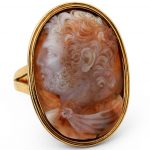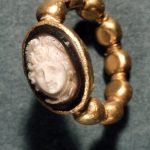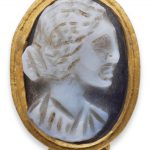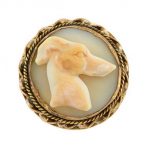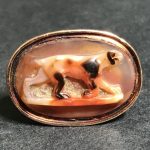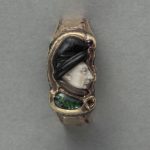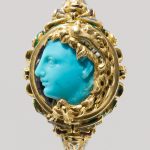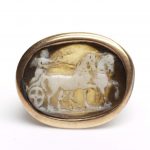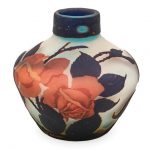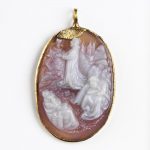Information and history of cameo rings. Cameo rings have been worn for centuries. The style of setting a cameo into a plain hoop mounted by a table setting is very ancient and was more commonly worn by men than women. Ancient cameos often depicted pagan gods, Christian saints and even self-portraits. Multi-coloured stone and often marble or porphyry was most desirable, as it produced a striped, layered or three-dimensional effect. The modern cameo ring usually shows the profile of a goddess or a Roman soldier. Reference: Wikipedia.
Below are some examples of cameo rings throughout the ages.
A 19th century gold and agate cameo ring Oval, depicting the profile of a bearded man with curling hair, facing left, wearing robes, within a yellow gold mount, French assay mark, cameo length 3.0cm, width 2.0cm, ring size Y
Sold for £ 9,375 inc. premium at Bonhams in 2016
Gold finger-ring set with a sardonyx cameo engraved with a head of Medusa with wings in her hair and snaky locks. Culture/period Roman term details Date1stC-2ndC
Reference: © The Trustees of the British Museum
A ROMAN AGATE CAMEO CIRCA 3RD CENTURY A.D. Mounted as a ring in a modern gold setting ⅞ in. (2.3 cm.) wide; ring size 5 ½
Sold for USD 3,000 at Christies in 2016
Antique Gold and Hardstone Cameo Dog Ring Mounting of later date, ap. 7 dwts. Size 8 1/4.
In good condition, normal wear with light surface scratches to metal. Gold rope twist mounting of a later date. Testing for 14k gold. Hardstone in good condition. Width: 1 to 3/16 inches.
Sold for $750 (includes buyer’s premium) at Doyle New York in 2017
Roman agate cameo ring of a dog, set in modern 14k gold mounting. Size 4, 4.5 dwts. Circa 2nd century AD.A wonderful example of Greek and Roman hardstone cameo carving.The dog is a pointer or bloodhound type, with the dark spots in the matrix of the stone being used as the dark spots on the dog’s ear and fur.
Sold for $800 at David Killen Gallery in 2018
Ring bearing the portrait of John the Fearless, Duke of Burgundy (1371-1419; as duke, 1404-19)
This gold ring with a bezel bears the portrait of John the Fearless, Duke of Burgundy (1371-1419). Combining several techniques-chasing, enamel, precious stones, and hard stone-this delicately worked piece reflects the exquisite taste of the early fifteenth-century court.
The face is sculpted from white agate, the black jade hat is decorated with a ruby, and the emerald garment has a fur collar of beige agate. Thus the piece combines chasing, enameling, and sculpture of hard stone. Both the exterior and interior of the ring bore inscriptions in black enamel: on the interior we can still make out some of the Gothic lettering of the Latin inscription, “Truly this was the Son of God,” uttered by one of the Roman centurions after Jesus’ death (Matthew 27:54, Mark 15:39). Unfortunately, the inscription on the outside is now totally effaced. On the underside of the bezel, however, we can readily make out an engraved planing tool overlaid with orange-yellow enamel. The use of such emblems was widespread in the late Middle Ages and this one was adopted by John the Fearless in 1406. Cameo rings of this kind were very much in fashion at the time and we know that John of Berry, the Duke’s uncle, had two of them. In its traditional combining of gold and colored stones, this piece reflects the fashion and taste for luxury of the style prevailing in the fifteenth century’s first decade.
Reference:The Louvre
Cameo ring possibly of Alexander the Great mid-16th century; cameo: early Hellenistic 4th century B.C. This vibrant carving has previously been described as made of glass and as a product of the French Renaissance, but it is in turquoise, a rarity in cameos of any period. That it is reputed to have been in the Este collections may make an Italian origin likelier. It is not to be ruled out even that the stone is Hellenistic, from as early as the fourth century B.C., but the heroic type of Alexander the Great’s profile was adopted by various Hellenistic successors. In any case, the person who caused it to be set surely thought of it as ancient and as representing Alexander. It is probably a fragment whose broken edges the goldsmith has deftly concealed by forming the bezel as a lion skin, a motif that Alexander borrowed from Hercules.
Reference: The Metropolitan Museum of Art
Agate and Colored Diamond Ring, Hemmerle The agate cameo featuring the profile of Socrates, bezel-set within a shank accented throughout with round diamonds of orangy brown hue, size 6¼, with maker’s mark, one diamond missing.
Sold for 13,750 USD at Sothebys in 2018
Horizontal oval cameo. White over pale brownish grey layered agate. ca. 200 BC-100 CE (made). Depicts Cupid, naked and winged, driving a chariot drawn to right by two horses. Set in a later gold ring.
This gem was part of the collection of the Reverend Chauncy Hare Townshend (1798-1868), who bequeathed his important collection to the South Kensington Museum in 1869. Although the gemstone collection is not as comprehensive as that found at the Natural History Museum, it is of particular historic interest as its formation pre-dates the development of many synthetic stones and artificial enhancements. All the stones were mounted as rings before they came to the Museum. Some are held in the Sculpture Section, other more elaborately mounted ones in the Metalwork Section. As well as being a clergyman, collector and dillettante, the Reverend Townshend wrote poetry. He met Robert Southey in 1815 and through him the Wordsworths, the Coleridges and John Clare. He was a friend of Charles Dickens and dedicatee of his novel ‘Great Expectations’.
Reference: © Victoria and Albert Museum
